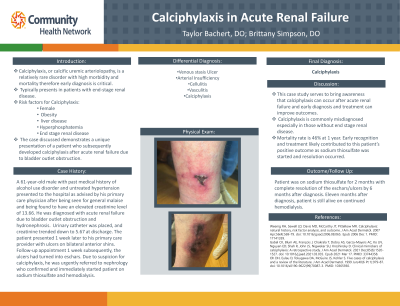Back

Clinical: General Topics
Calciphylaxis in Acute Renal Failure
Friday, March 31, 2023
12:00 PM East Coast USA Time

- TB
Taylor M. Bachert, DO (she/her/hers)
Doctor of Osteopathic Medicine
Community Health Network
Indianapolis, Indiana, United States
Presenting Author(s)
Introduction: Calciphylaxis, or calcific uremic arteriolopathy, is a relatively rare disorder with high morbidity and mortality that commonly presents in patients with end-stage renal disease. Early diagnosis and treatment is critical. The case discussed demonstrates a unique presentation of a patient who subsequently developed calciphylaxis after acute renal failure due to bladder outlet obstruction. This case study serves to bring awareness that calciphylaxis can occur after acute renal failure and early diagnosis and treatment can improve outcomes.
Case Study: A 61-year-old male with past medical history of alcohol use disorder and untreated hypertension presented to the hospital as advised by his primary care physician after being seen for general malaise and being found to have an elevated creatinine level of 13.66. He was diagnosed with acute renal failure due to bladder outlet obstruction and hydronephrosis. Urinary catheter was placed, and creatinine trended down to 5.67 at discharge. The patient presented 1 week later to his primary care provider with ulcers on bilateral anterior shins. Follow-up appointment 1 week subsequently, the ulcers had turned into eschars. Due to suspicion for calciphylaxis, he was urgently referred to nephrology who confirmed and immediately started patient on sodium thiosulfate and hemodialysis. Patient was on sodium thiosulfate for 2 months with complete resolution of the eschars/ulcers by 6 months after diagnosis. Eleven months after diagnosis, patient is still alive on continued hemodialysis.
Discussion: Calciphylaxis is commonly misdiagnosed and has a high rate of mortality. One study showed 73.1% of cases were initially misdiagnosed and were more likely to be misdiagnosed without end-stage renal disease with an increasing prevalence in hemodialysis patients. This case was abnormal as it started after an acute renal injury, the patient was not on hemodialysis, and the patient lacked other common risk factors. Clinicians must have a high index of clinical suspicion to diagnose calciphylaxis and be aware that it can occur in patients without a diagnosis of end-stage renal disease.
Mortality at 1 year is 47% with the most common cause of death being sepsis. Of those who develop wounds/ulcers, only 20% live more than 6 months. Early recognition and treatment likely contributed to this patient’s positive outcome as sodium thiosulfate was started and resolution occurred.
Patient was not treated with Osteopathic Manipulative Treatment but would consider adding to treatment plan to help increase blood flow to promote healing of ulcers.
Case Study: A 61-year-old male with past medical history of alcohol use disorder and untreated hypertension presented to the hospital as advised by his primary care physician after being seen for general malaise and being found to have an elevated creatinine level of 13.66. He was diagnosed with acute renal failure due to bladder outlet obstruction and hydronephrosis. Urinary catheter was placed, and creatinine trended down to 5.67 at discharge. The patient presented 1 week later to his primary care provider with ulcers on bilateral anterior shins. Follow-up appointment 1 week subsequently, the ulcers had turned into eschars. Due to suspicion for calciphylaxis, he was urgently referred to nephrology who confirmed and immediately started patient on sodium thiosulfate and hemodialysis. Patient was on sodium thiosulfate for 2 months with complete resolution of the eschars/ulcers by 6 months after diagnosis. Eleven months after diagnosis, patient is still alive on continued hemodialysis.
Discussion: Calciphylaxis is commonly misdiagnosed and has a high rate of mortality. One study showed 73.1% of cases were initially misdiagnosed and were more likely to be misdiagnosed without end-stage renal disease with an increasing prevalence in hemodialysis patients. This case was abnormal as it started after an acute renal injury, the patient was not on hemodialysis, and the patient lacked other common risk factors. Clinicians must have a high index of clinical suspicion to diagnose calciphylaxis and be aware that it can occur in patients without a diagnosis of end-stage renal disease.
Mortality at 1 year is 47% with the most common cause of death being sepsis. Of those who develop wounds/ulcers, only 20% live more than 6 months. Early recognition and treatment likely contributed to this patient’s positive outcome as sodium thiosulfate was started and resolution occurred.
Patient was not treated with Osteopathic Manipulative Treatment but would consider adding to treatment plan to help increase blood flow to promote healing of ulcers.
